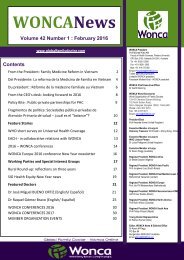Create successful ePaper yourself
Turn your PDF publications into a flip-book with our unique Google optimized e-Paper software.
ROUTINE ANTENATAL CAREAssess the pregnant patient at booking visit and 4 follow-up visits at 20, 26–28, 32–34, 38 weeks.Assess When to assess NoteSymptoms Every visit Manage symptoms as per symptom page.Estimated deliverydateBooking visit• Plot on antenatal card.• If patient ≥ 42 weeks, confirm EDD and symphysis-fundal measurement and refer for fetal evaluation and possible induction of labour.TB Every visit • If cough ≥ 2 weeks, weight loss, poor weight gain or anaemia, check for TB 55.• If patient has TB refer for secondary hospital antenatal care.Mental health Every visit • If 2 or more of: a difficult major life event in last year, unhappy about pregnancy, absent or unsupportive partner, previous depression or anxiety, or experiencing violence at home,screen for depression/anxiety 81. See also traumatised/abused patient 53.• > 14 drinks/week, > 5 drinks/session or misusing illicit or prescription drugs, screen for substance abuse 83. Refer for secondary hospital antenatal care.Mid upper arm Booking visit• MUAC < 23cm: exclude TB and HIV, check weight at every visit, refer for nutritional support.circumference• MUAC > 33cm: continue routine antenatal care but deliver at secondary hospital. Assess and manage CVD risk 68.AbdominalexaminationEvery visit• If mass other than uterus in abdomen or pelvis, refer for assessment.• Measure symphysis-fundal distance and plot on antenatal card. Refer for assessment if discrepancy with EDD, 90th centiles, or multiple pregnancy likely.• Look for breech presentation. If present at 32/34 and 38 weeks, refer to high risk clinic.Vaginal discharge Every visit • If abnormal discharge, treat for STI 23. If discharge is runny, suspect premature rupture of membranes 93.BP Every visit BP is normal if < 140/90. If raised, repeat after 1 hour rest. If 2nd BP normal: repeat BP after 2 days. If 2nd BP still raised: check urine dipstick for protein:• No proteinuria: start methyldopa 250mg 8 hourly and refer same week to high risk clinic.• ≥ 1+ proteinuria: refer patient same day. If abdominal pain, blurred vision, headache, treat for pre-eclampsia 93.Urine dipstick: test Every visit • If leucocytes and nitrites in urine treat for complicated urinary tract infection 31.clean, midstream• If protein in urine and BP < 140/90: if dysuria, frequency, treat for complicated urinary tract infectionurineand BP < 140/90, refer to the nearest doctor’s clinic same week. If BP raised see above.31. Repeat urine dipstick for protein after 2 days - if still 1+ proteinuria• If glucose in urine, check random blood glucose.Random bloodglucoseIf glucose in urine• If random blood glucose ≥ 11: refer to high risk clinic same day. If glucose > 15 and ketones in urine, give sodium chloride 0.9% IV 1l 4 hourly and short-acting insulin 10IU IM.• If random blood glucose 8–11, repeat blood glucose after an 8 hour fast.--Fasting blood glucose 6–8: assess and manage CVD risk 68. Refer to high risk clinic for next antenatal visit.--Fasting blood glucose ≥ 8: refer to high risk clinic same day.HaemoglobinBooking visit and if patientpale• Refer to high risk clinic if < 34 weeks and Hb < 8, or ≥ 34 weeks and Hb < 10.• Treat if Hb < 10 96. Repeat Hb monthly.Rapid rhesus Booking visit If rhesus negative refer to high risk clinic.Rapid syphilis Booking visit If positive do RPR and give benzathine penicillin 2.4MU IM single dose and see in 1 week for result 28.HIVBooking visit, 3 monthly • If status unknown test for HIV 60. If patient refuses, offer at each visit, even in early labour.and at 32 weeks if negative • If HIV give routine HIV care 61. If not on ART, do baseline bloods (CD4 and creatinine ) and start ART same day 63. Review within 1 week.CD4, stageBooking visit if HIV not onART• If CD4 > 350 and stage 1 or 2: continue ART as prophylaxis through antenatal, delivery and postnatal care until 1 week after last breastfeed.• If CD4 ≤ 350 or stage 3 or 4: continue ART as lifelong treatment.Viral load • If on ART: at booking visit. • If patient already on ART, check viral load at booking visit. If patient starting ART, check viral load at 6 months and then yearly.• If viral load ≥ 400, discuss with specialist same day to consider switching ART regimen.95



